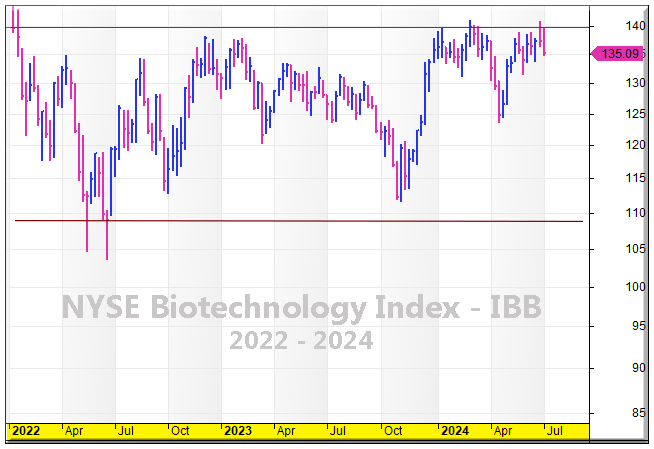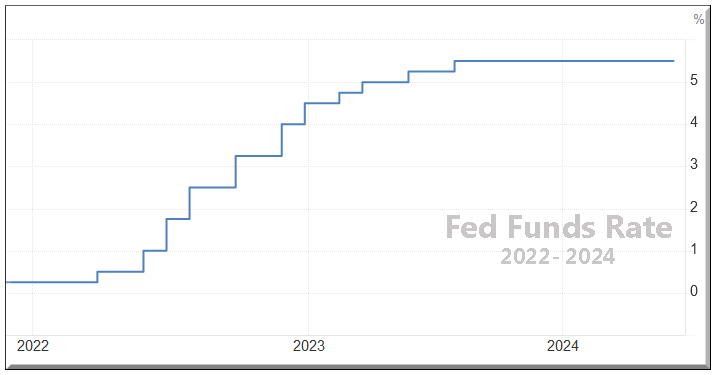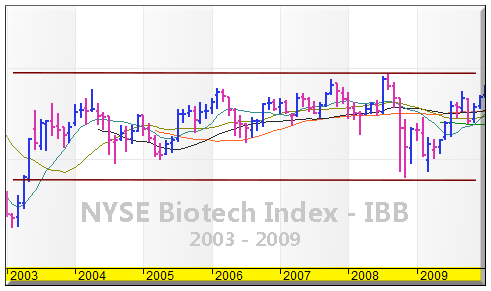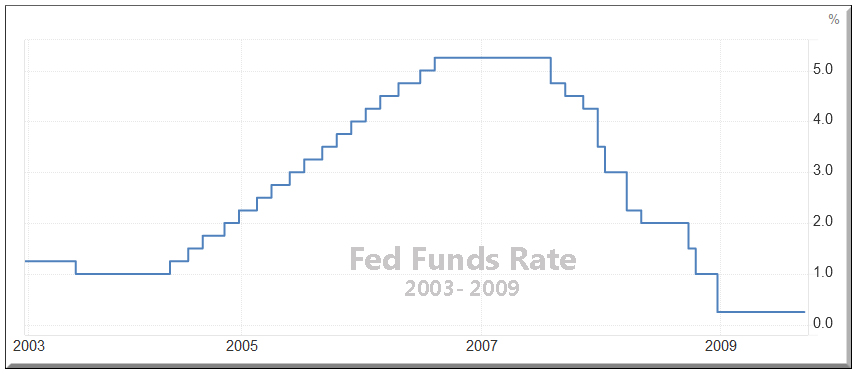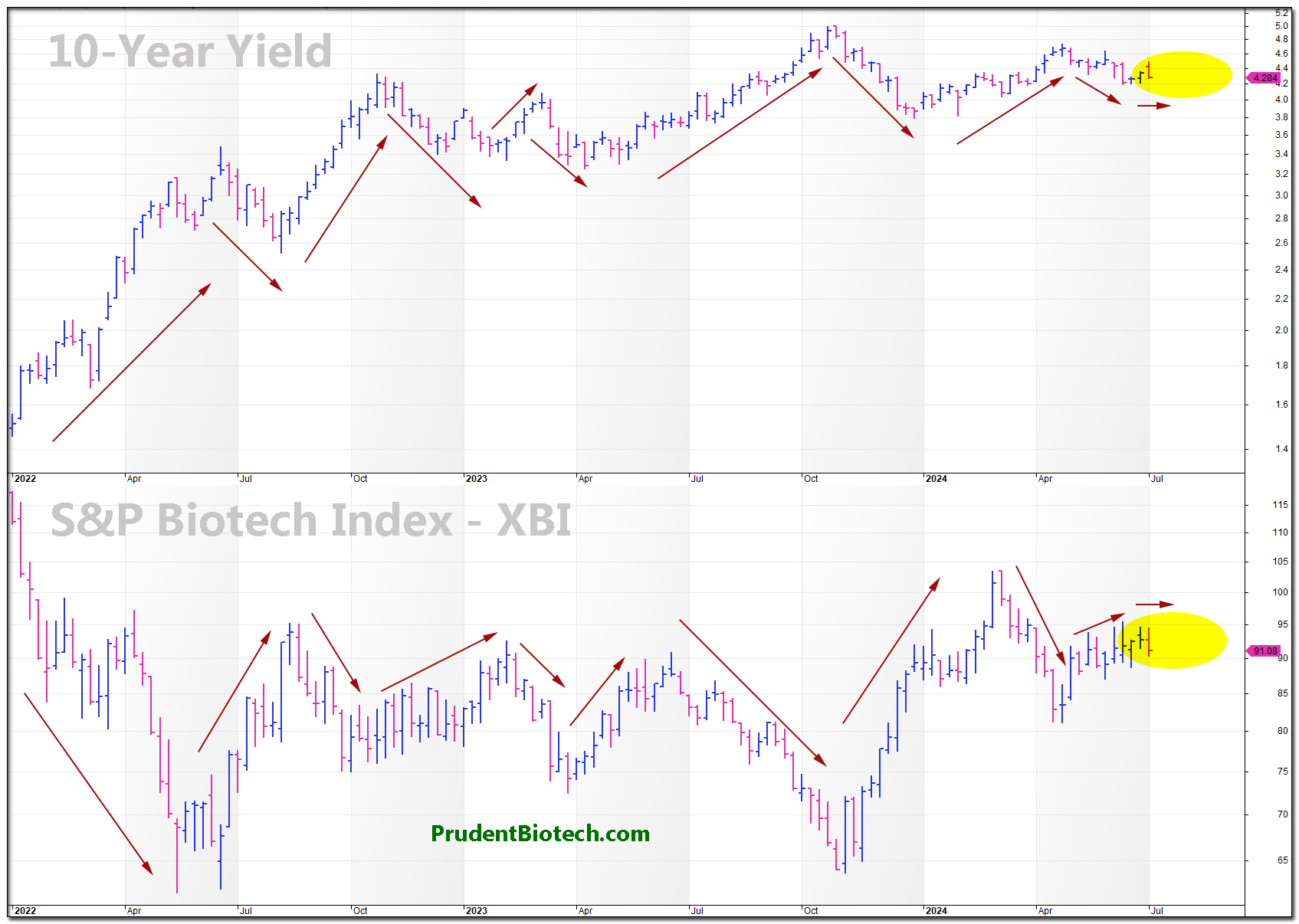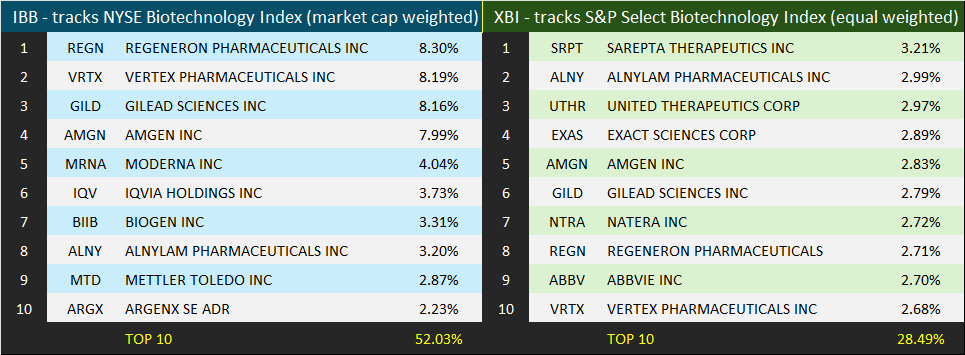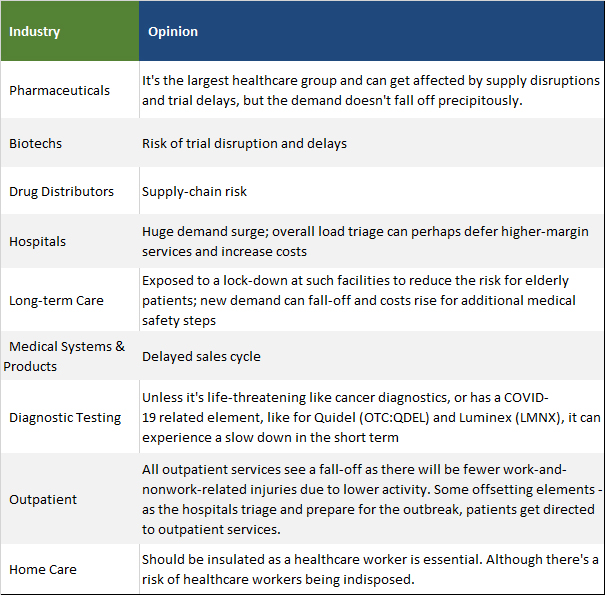Biotech Pulse
During the first half of 2024, biotechnology indexes lagged as broader market indexes reached new highs. The Nasdaq (QQQ) and S&P 500 (SPY) indexes increased by 18% and 15%, respectively. The Nasdaq Biotechnology Index (IBB) rose by 1%, the S&P Biotechnology Index (XBI) increased by 3%, while the Prudent Biotech model portfolio lagged behind these indexes.
While biotechs underperformed, so did most companies in the S&P 500. According to a WSJ report, over half of S&P 500 companies have declined since the start of 2022, with index gains driven significantly by the largest technology stocks.
Investing in biotechs has been challenging over the past two years due to the impact of rising interest rates. Avoiding biotech investments did not hurt returns, as the stock market has largely sidelined this industry group.
However, the second half of 2024 holds potential for biotech stocks to break out of their multi-year consolidation as market sentiment can shift in favor of biotechs.
Currently, the key factor affecting biotech valuations is the restrictive interest rate environment. A favorable rate environment can provide an industry-wide wind that boosts biotech valuations. Thus, a discussion on the biotech industry outlook in the second half becomes a discussion on the outlook of interest rates, the critical macro factor driving the group's valuations.
This report is a follow-up to our 2024 outlook published in January.
Biotechs Tied to Interest Rates
Biotech indexes are trading at the same level as in January 2022. Despite being better capitalized and delivering promising advances in medical science, biotechs have been unable to break out over 2.5 years.
As noted in our past articles, biotech valuations are closely linked to interest rates. The Federal Reserve's rate hikes since early 2022 have significantly impacted these valuations.
The biotech group, being higher risk and speculative, is more sensitive to rising rates, which increases the risk premium and lowers valuations.
Historically, during periods of rising interest rates, such as from 2004 to 2009, biotechs remain in a trading range and break out once the policy shifts and settles into rate cuts. Such was the case preceding the financial crisis, when the group remained in a tight range for many years as interest rates climbed.
The biotech group, being higher risk and speculative, is more sensitive to rising rates, which increases the risk premium and lowers valuations.
Historically, during periods of rising interest rates, such as from 2004 to 2009, biotechs remain in a trading range and break out once the policy shifts and settles into rate cuts. Such was the case preceding the financial crisis, when the group remained in a tight range for many years as interest rates climbed.
It took rate cuts for biotechs to rebound sharply.
In a higher interest rate environment, like the current one, biotech stocks remain range-bound due to increased investor risk aversion and limited potential for valuation expansion. They typically break out immediately preceding or after policy change. If rates continue to trend downwards, biotechs can see a prolonged uptrend.
We are approaching such an inflection point. A policy shift in the second half of the year could be highly favorable for biotechs, even if the broader market faces cyclical challenges due to lower growth.
Biotechs Remain Highly Correlated
to the 10-year Yield
The direction of the 10-year bond yield is crucial for biotech valuations, acting as a discount rate for these higher-risk growth companies. A robust negative correlation exists between the yield curve's trajectory and biotech performance, as shown in the chart below.
For Biotechs to Rise, The Yield Must Fall,
And It Will Fall
The 10-year yield will fall in the upcoming months.
In the inflation readings over the next three months, before the September Fed meeting, we anticipate inflation will moderate consistently. It now appears to be inevitable. The unemployment rate has trended higher consistently over the past 3 months, and that foretells an upcoming slowdown in economic activity. It may not be a material slowdown, but sufficient to push treasury yields lower. However, even a gradual but consistent shift in the labor market can still hurt economic activity.
The inflation-related improvement is not just in the conditions around a historically tight labor market. More than 50% of the CPI index components are now at pre-pandemic rates. Additionally, during what is typically a peak home construction season, lumber prices have plummeted to post-pandemic lows, indicating further economic cooling.
The Fed now has the economic pieces positioned favorably on its decision board. Economic growth is slowing, job growth is slowing, and inflation is slowing. It is becoming harder to justify a Fed Funds range of 5.25% to 5.50%, when inflation is 2.6%. Perhaps, if core inflation data later this week, and consumer spending data out later this month, show subdued growth, the Fed will consider dropping a hint of an upcoming rate cut at its July meeting.
What are IBB and XBI?
These are two biotech industry-focused ETFs that track their respective biotech indexes and present a way to acquire a broad industry exposure.
iShares Biotechnology ETF (IBB): This ETF aims to replicate the total performance of the NYSE Biotechnology Index. It is market cap-weighted, giving more weight to larger-cap stocks. The NYSE Biotechnology Index has about 212 companies. At the time of submission of the article, the last closing price of IBB on July 5 was $136.20.
S&P SPDR Biotech ETF (XBI): This ETF seeks to replicate the performance of the S&P Biotechnology Select Industry Index. It is a modified equal-weighted index, providing about equal exposure to large, mid-, and small-cap stocks. The S&P Biotechnology Index has about 140 companies. The last closing price of XBI was $91.71.
Below is a table of the top ten holdings for IBB and XBI as of the end of Friday, July 5, 2024.
Conclusion
The Fed is likely to shift its policy towards cutting interest rates, quite possibly from September. Although economic forecasting is challenging, the probability favors a rate cut and a sharp decline in yields in the second half, making biotechs an attractive consideration.
The Fed now will have to focus not just on inflation, but also on the weakening labor market due to its restrictive policy and the highest real interest rates of this rate hike campaign. The stock market would prefer a rate cut driven by receding inflation rather than declining growth. If economic activity slows down significantly, the stock market will run a higher risk of a sharp pullback, but healthcare, including biotechs, should still outperform.
We believe biotechs are a buy for the second half, driven by the 10-year treasury yield falling to 4% or lower and a Fed rate cut. Although there may be yield fluctuations in the coming months and volatility related to slowdown concerns, which will put short-term pressure on biotech stocks, the overall yield trend is likely to reverse lower and be supportive. Biotechs should perform well in the second half, potentially surpassing the performance of broader market indexes. We anticipate the biotech rally until October, when election uncertainty will create a typical risk-off environment until the election concludes.
Industry exposure can be acquired through ETFs like IBB and XBI. There are many promising large and small biotech companies, some of which may already be part of the Prudent Biotech model portfolio. A few of these include, Vertex Pharmaceuticals (VRTX), Amgen (AMGN), Revolution Medicines (RVMD), Alnylam (ALNY), Nuvalent (NUVL), Blueprint Medicines (BPMC), Viking Therapeutics (VKTX), Madrigal Pharmaceuticals (MDGL), Insmed (INSM), Crinetics Pharmaceuticals (CRNX), Adma Biologics (ADMA), Janux Therapeutics (JANX), Stoke Therapeutics (STOK), Merus (MRUS), Corbus Pharmaceuticals (CRBP), and Agenus (AGEN).
This article was first published on Seeking Alpha

